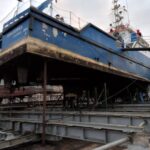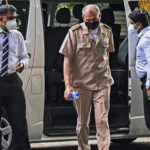His Excellency the president Ranil Wickremesinghe declared opened the third session of the ninth Parliament and delivered the government’s policy statement which highlighted that, before the end of the 21st century, the Indo-Pacific Region will be the most powerful economic domain in the world. Further he elaborated, “In this context, the strategic geographical location of our country is extremely important. We should make the best use of this favorable position. Bearing this in mind, our future corporate laws and policies should be formulated”. He also urges in compiling rules and regulations and policies that will allow our country to get maximum benefit from the Indian Ocean centric new economic power.
Hydrography play an important role in Ocean centric economy. To accept the definition of ASEAN, to avoid unwarranted war and to not involved in big power rivalry in Indian Ocean region as emphasized by the President in his speech in National Defense college on 14 September 2022, armed forces of Sri Lanka to look at the whole region of Indian ocean and the security of Sri Lanka, hydrographic data will involve and influence the security of region as well as the national security of Sri Lanka.
Sri Lanka Navy (SLN) had been vested the authority in carrying out Hydrography services in the country until 1984, admits of other operational commitments it was handed over to National Aquatic Resources Research and Development Agency (NARA) by the Act No. 54 of 1981. In 1996, the aforesaid act was amended as NARA Amended Act No. 32 of 1996. By this act without any concern of the Ministry of Defense on hydrographic aspect, National Hydrographic authority handed over to National Hydrographic Office (NHO) function under the NARA.
Surveys, charts, and the language of hydrography became central to the Navy’s war planning and war gaming, to the strategic debate over where to establish naval bases and to identify beach heads, ultimately, it figured significantly in determining the geography of the country. By the end of the war, new strategic ideas, technologies, and the imperatives of the country caused naval officers to think about the sea in new ways in par with international standards. Sri Lanka Navy Hydrographic Services (SLNHS) reactivated since 2012 and significantly improve its capabilities in term of qualified human resources and infrastructures, which include modifications of naval vessel for Hydrographic surveys.
Sri Lanka ratified International Convention for the Safety of Life at Sea (SOLAS) and entered in to force since 25 May 1980. As per the SOLAS Chapter V – Regulation 9, contracting governments to ensure that hydrographic surveying is carried out, as far as possible, adequate to the requirements of safe navigation; to prepare and issue nautical charts, sailing directions, lists of lights, tide tables and other nautical publications, where applicable, satisfying the needs of safe navigation. Further, contracting governments to provide data management arrangements to support these services and to co-ordinate their activities to the greatest possible degree in order to ensure that hydrographic and nautical information is made available on a world-wide scale as timely, reliably and unambiguously as possible. Regulation 4 of SOLAS Chapter V places an obligation on contracting governments to ensure that appropriate navigational warnings are issued.
All Indian Ocean Region countries (Except Sri Lanka and Saudi Arabia) recognized the operational sensitivity of the hydrographic data, hence the National Hydrographic authority vested on their naval arm in order to regulate hydrographic data outflow and to maintain national interest. Latest annual report (2020) and official NARA website indicted that, 90% of the hydrographic services carried out by NHO are related to inland water bodies and consultancy services. No national nautical publications accordance with SOLAS regulations are published by the NHO up to date. NHO is to represent Sri Lankan Hydrographic services in International Hydrographic Organizations (IHO) hence its vision and operations are to be in par with the required standard stipulated by the IHO. Following drawback and salient points are the main consideration for transforming National Hydrographic Authority to SLNHS,
a. National Security: Most of the hydrographic data include operational sensitivity (Data of focal points of the country; high populated bathymetry data, magnetic nature, changes of gravity, propagation of sound waves, temperature variations and the behavior of ocean currents, sediments and core samples) hence to be handle with greater care and should not be challenged to the National security. Ultimate responsibility should be lies with MOD through the Navy.
b. Hydrographic Data Outflow: Due to the leniency in laws and regulations in the country related to Hydrographic surveys, at the moment, local and foreign institutions who are interested in Indian Ocean Region have collected various hydrographic data in Sri Lankan waters with collaborator with only NARA. Outflow of this data to be regulated and MOD representation is mandatory through the capable body as SLNHS.
c. Economy of effort: Multi Beam Echo Sounder (MBES Advance equipment for acquiring bathymetric data) worth around 40 million was purchased in 2004 to the National Hydrographic Office (NHO). However, no chart produced from MBES data collected from this equipment so far and it has placed non-operational for long period of time.
d. Influence of other nations: India has published 10 nautical (Paper) charts and 04 Electronic Navigation Charts (ENCs) in SL waters without concern of any responsible authority. National Hydrographic Office is responsible for publishing new charts and update for the charts in Sri Lankan waters. NHO has not asserted any reluctance regarding this venture which can be an
immense threat to the National security.
e. International Representations: NHO is to represent Sri Lanka in IHO and should reply for the circulars and instructions shared by the international body. No response was given to some circulars and not studied them against national interest. Ex; CL 18 (2019) and CL 21 (2020) about Crowd Sourced Bathymetry.
f. Scarcity of resources and manpower: Annual report (2020) indicated inability to conduct hydrographic survey beyond 200m couture which in some area lies within 10nm. Support seek from SLN to conduct survey beyond 200m couture. The last survey in the coastal line of Sri Lanka was conducted on 1875-1950 by the Royal Navy and very old data is existing around the Sri Lanka. Therefore, it is an essential updating national charts as per chapter (V) of SOLAS convention.
SLNHS with qualified human resources, well equipped and proven efficiently is to be vested with National Hydrographic Authority in order to address above drawbacks and to preserve national security. Further, relevant amendments are required to be made for the NARA act. Then, SLNHS will act as National Hydrographic Office supporting ocean centric economy of the president’s policy statement in efficient and effective manner.
Ayesh Indranath Ranawaka
Editor in Chief
oceanlust magazine.





